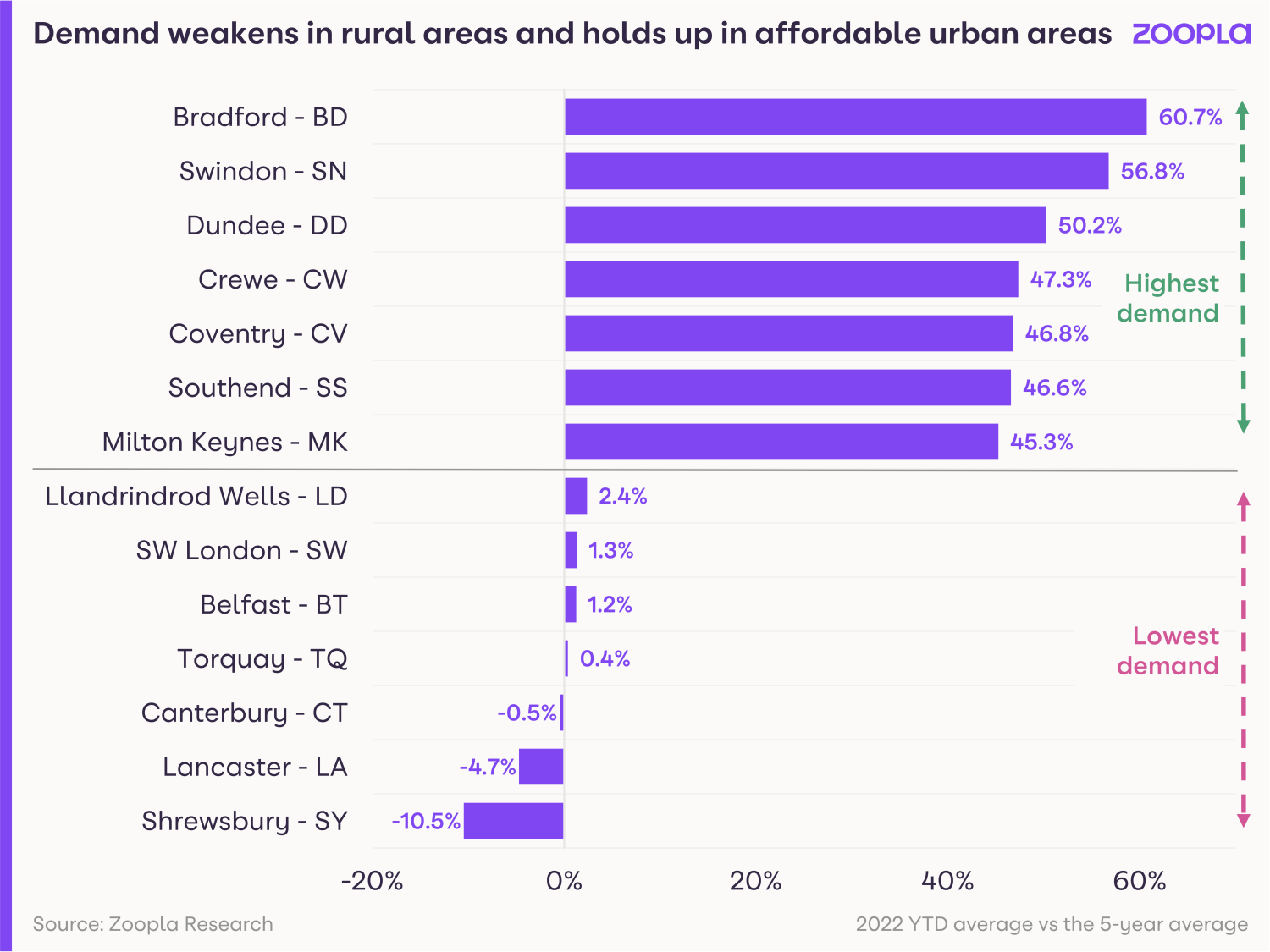Buyers on the hunt for affordable cities and flats in 2023
Apartments and urban areas set for a comeback as buyers prioritise affordability and value for money.
Affordability and value for money will be the big key drivers for the housing market in 2023.
These two factors are going to flip the flight to rural and coastal areas, which has dominated the housing market in recent years, into reverse.
Instead, apartments and urban areas, which lost some of their popularity during the pandemic as the nation began the search for more space in idyllic locations, are making a comeback.
Executive Director for Research, Richard Donnell says “The dynamics that have shaped the housing market over the last 5 years are shifting.
“We expect affordable urban centres to fare better than average in 2023 but the inner London market may require another year before it is ready to rebound.”
Why are urban areas becoming popular again?
Influenced by higher mortgage rates, household incomes and the actual level of house prices, buyers are being priced out of the more expensive markets, preferring to look in areas where homes are more affordable.
Increasingly keen to secure homes in urban settings, where jobs are being created and more services are available, buyers are now showing a stronger preference for towns and cities.
The popularity of family homes in city suburbs and commuter areas is also rising, with demand for homes in these areas climbing to above average levels over the last year.

How rising mortgage rates are affecting where buyers choose to live
Mortgages are currently needed for seven out of every 10 home purchases.
Higher mortgage rates are currently affecting what many people can afford to buy, as they mean more income is needed to secure a sale.
The more expensive a market, the greater the number of households that are priced out.
This in turn weakens demand, leading to fewer sales and possible price reductions to secure those sales in these areas.
In affordable markets with lower average house prices, the opposite is true.
Why affordable markets will fare better in 2023
As demand for more affordable areas increases in 2023, these markets are likely to fare better than their more expensive counterparts in terms of price falls over the coming months.
Most housing markets have recorded house price gains of 25.4% over the last 5 years. That's above the level of consumer price inflation (+19%) and average earnings (+22%) over the same time period.
Economic growth, good affordability and low mortgage rates have all enabled above average price gains over this period.
The Oldham postal area recorded the highest price increases since 2017 at +47%, while Newport, Swansea and Bolton also enjoyed high value gains.
However, we expect house price growth to slow in these higher-growth markets in 2023.
UK house prices are predicted to fall by an average of 5% next year.
But in the more affordable markets, the falls are likely to be lower, as the hit to buying power from higher mortgage rates will be felt less keenly.
Which affordable cities are buyers interested in?
Major towns and cities, including Bradford, Swindon, Coventry, Crewe, Milton Keynes and Southend are all registering above-average demand.
These areas all have their own employment base, but they also enjoy good transport connections into much larger employment centres, such as London, Leeds, Manchester and Birmingham.
We believe employment growth will continue to stimulate housing demand in these affordable city regions throughout 2023.

Why flats are becoming better value for money
Apartments make up around 1 in 5 homes in the UK, but price inflation for them has lagged behind the growth enjoyed by houses.
Across the UK, houses are currently valued at just over twice the price of flats. That’s the highest price difference seen for 20 years.
In the capital, the average price of a house is 1.7x the price of a flat, up from 1.4x a decade ago.
Flats haven’t experienced those same value gains as houses partly because the search for space made them a less popular option during the pandemic, but also because buyers were experiencing concerns over cladding and leasehold charges.
The chart below tracks the average price of flats and houses since 2002.

However, we expect demand for flats to increase throughout 2023, as buyers seek better value for money.
The government’s moves to ensure cladding problems are remediated in most buildings will also help to boost their popularity further.
What should first time buyers do in 2023?
What will happen with the London housing market in 2023?
London and its commuter areas have under-performed in recent years.
With prices already at the highest end of the market, affordability is already stretched for buyers in the capital.
In central London - and the commuter areas surrounding it - the scope for price increases over the last 5 years has been limited, despite the ultra-low mortgage rates that were available until the middle of this year.
Prices have been falling slightly in central London since 2017 and are now 17% lower in real terms, allowing for inflation.
That said, earnings have been rising at a faster pace than prices since 2017, which is slowly improving affordability.
Still, average prices remain high by national standards and of course, mortgage rates are now higher than last year.
We expect the inner London housing market to rebound soon, but this requires a further improvement in housing affordability.
In the meantime, we expect London house prices to register above-average price falls of 5% to 8% in 2023, which will improve affordability, alongside our expectation of lower mortgage rates.
We also believe that a resurgence in employment growth will be the trigger for a turnaround in this under-performing market in the next 1-2 years.
Key takeaways
- Tide turns on the desire for coastal and rural areas as demand for affordable cities and apartments rises
- Buyers once again attracted to urban settings with plenty of jobs and services
- The dynamics that have shaped the housing market over the last 5 years are shifting
What should first time buyers do in 2023?
From the better value of flats to discounts and price falls, here's how a slower housing market could benefit first time buyers in 2023.
Low mortgage rates have meant first time buyers could often afford a three bedroom semi with a double driveway and a big garden over the past 2 years.
But with mortgages more expensive - plus higher living costs - you might be wondering about your chances of stepping onto the property ladder in 2023.
Our latest House Price Index shows buyers have been stepping back from the market, with demand down 50% against this time last year.
But a slower housing market can bring opportunities for first time buyers. If you know where to look and when to make your move.
Let’s take a look at how you could step onto the property ladder in 2023.
Look to flats for better value for money
Price growth for flats has been much slower than for houses in the last 10 years. This means a flat could give you the chance to buy at a cheaper price for greater value for money.
After the pandemic, there was a rush towards houses as everyone wanted more space. Demand for flats dropped and values rose at a slower rate than house values.
In London, you’ll spend 1.7 times more on a house than you will on a flat. 10 years ago, a London house was only 1.4 times more expensive.
It’s a similar picture across the rest of the UK, where you’ll pay 2.1 times more for a house than a flat - the highest differential in 20 years.
If you want to save money by buying a flat, make sure you’re aware of the extra costs and considerations.
Check if the property is for sale as freehold or leasehold, find out the cost of service charges and ground rent, and make sure it’s clear who will pay for repairs and maintenance to the building.
We expect more buyers to realise the relative value to be found in flats in the coming months, which will increase demand for flats later in 2023. This will also be supported by the government’s commitment to fix cladding issues, which impact a small proportion of flats in the UK.
Put in an offer: sellers will be more open to negotiations in 2023
Sellers are now accepting offers 4% below asking price on average, which works out to a £10,500 discount on the average home right now.
It’s already a big change from a few months ago - in October, buyers were not getting any wriggle room from sellers and we recorded an average discount of 0%.
We think this trend will keep going and you may be able to get an even bigger discount from sellers in 2023.
If you’re looking to buy soon, keep in mind that December is not usually the best month for discounts or reductions to asking prices.
It might be worth making that cheeky offer in the New Year instead, as sellers often wait to see if new buyers will come into the market the first week of January.
Keep an eye out for small drops in house prices
While house prices are up 7.2% over the last year - or £17,500 on average - price growth has stalled since the summer.
In the last 3 months, house prices have only risen 0.3%, compared to 2% in the summer.
And we’re expecting to see house prices fall in the first part of 2023, with annual price falls coming in by mid-year.
If our predictions are right, it’ll be the first time we’ve seen annual price falls for years, meaning a small respite for first time buyers who have faced continually rising prices and strong competition.
Generally speaking, the biggest house price falls will come in the south of England, where house prices are more expensive.
If you’re looking to buy in a high value market, this could give you the chance as competition eases and sellers start to reduce their prices to achieve a sale.
While you might find it harder to get a mortgage, buying remains cheaper than renting an equivalent home everywhere in the UK apart from London.
When you’re looking at homes for sale, check if the price has already been reduced with our ‘listing history’ tab. It can give you an idea if there might be room for the price to be discounted.
Be ready to move quickly in affordable urban areas
In lower-value markets, we’re still seeing high demand as mortgage rate rises have had less of an impact.
Demand is tracking at above average levels in affordable urban areas like Bradford, Swindon, Coventry, Crewe, Milton Keynes and Southend.
But first time buyers have the advantage of flexiblity and the ability to progress quickly, which gains even more favour among sellers in a softening market.
We expect these affordable areas will see above-average house price rises in the next year – but it’ll be at a much slower rate than in the last 2 years.
So if you need to save for a little longer or want to see if mortgage rates drop further, you won’t be seeing the same price rises as recent years and may find you’re in a better position by mid-2023.
Director of Research and Insight, says: "First time buyer demand is expected to hold up in 2023 as the rapid growth in rents makes buying look attractive - even as mortgage rates increase.
"This is particularly the case in regions outside the south of England where mortgage repayments are lower than monthly rental costs, even with 5% mortgage rates.
"Rents are expected to rise further in 2023 adding to the impetus to buy. However, raising a deposit will remain the biggest challenge for first time buyers as the best mortgage rates will be for lower loan-to-value mortgages."
Whatever your situation, we always recommend getting independent financial advice before you go ahead.
Key takeaways
- Flats are offering the best value for money for 20 years across most of the UK
- Sellers are already giving 4% discounts on average and they’ll be even more open to negotiations in 2023
- House prices will start to drop in the new year, with the most expensive areas seeing the biggest price falls
- Many urban areas are still affordable despite high demand, including Bradford, Swindon, Coventry, Crewe, Milton Keynes and Southend.
3 reasons why the housing market might defy expectations in 2023
Mortgage rates hitting 6.5% brought many predictions of sizeable house price falls in 2023. But we're less bearish and believe the housing market will be stronger than many expect next year.
Cost of living pressures and higher mortgage rates have dented interest from new homebuyers in the second half of 2022.
The spike in mortgage rates to 6.5% after the mini budget caused widespread alarm, given mortgage rates were just 2% at the start of 2022. Housing market activity has stalled since October as buyers and sellers stand back and wait to see what the outlook is like in January 2023.
Many forecasters have put out bearish predictions for 2023, anticipating house prices falls of 8% to 12% and a significant fallback in sales numbers. Most of these projections are based on expectations of high mortgage rates over 2023 and an economic recession lasting into 2024.
While the outlook is less certain and more challenging for a growing number of households, we are more positive about the prospects for house prices and sales volumes in 2023 for 3 broad reasons.
1. Banks are keen and ready to lend
Many people are looking back at history to draw parallels, in particular the 2007-09 downturn. The 12% drop in house prices over this period was driven by a lack of credit, in that few banks were willing to lend to anyone but the safest customers. This reduced demand for homes and prices fell.
Price falls were also amplified by banks loosening their lending criteria in the run-up to 2007. A third of borrowers didn't prove their income to their bank in 2007 when applying for a mortgage.
Things are very different today.
UK banks are very well capitalised and their business plans are subjected to regular testing against major downturns in house prices and economic growth. All our high street lenders are mortgage-focused businesses and they will want to make sure credit is available to those that need it in 2023, albeit with higher mortgage rates than at the start of 2022.
Higher interest rates means banks will become more profitable. For existing borrowers, banks are developing a range of options to make sure customers can afford the jump in mortgage rates as they come to the end of fixed term deals.
2. Mortgage rates are dropping
The other big change in recent weeks has been a fall in the cost of money that underpins mortgage rates.
The vast majority of us take fixed rate loans of up to 5 years. After the fallout from the mini budget, the recent fiscal plan from the government has calmed money markets again. This has seen the underlying cost of mortgages fall back to where it was starting to move to earlier in the year.
This means typical mortgage rates for new borrowers taking a 5-year fixed rate will be in the 4.5% to 5% range at the start of 2023.
Higher loan-to-value mortgages will see the higher mortgage rates while those with the biggest deposits, or the most equity in their home, will get the best rates. This factors in further modest increases in the Bank of England base rate in the short term to bring down inflation.
The other important thing to note about mortgage costs is that every homeowner who took out a mortgage over the last 5 years had to prove to their bank they could afford a 6.5% to 7% mortgage rate, even though they may have been paying just 1% or 2%. This so-called affordability stress test was designed to to make sure buyers could afford higher rates.
This is important, and means the housing market has effectively been operating in the background at 6.5% to 7% mortgage rates. It is another key reason we see evidence of underlying resilience in the housing market. If everyone had been buying based on whether they could afford 2% mortgage rates, house price growth would've been much higher and we would now be expecting much bigger price falls as a result.
3. Motivations to move home remain
The impacts of the pandemic continue to shape the desire to move home. People who expect to work more flexibly are 6 times more likely to move than those that don't expect any change in their working style. The proposals from the government to make flexible working more open to employees will support this trend and further loosen the ties between where people live and work.
The pandemic also brought on a jump in the number of people leaving the labour market for health reasons and retirement, which are big triggers for home moves. Those retiring are more likely to have paid off their mortgage or have a small mortgage, so higher mortgage rates are less of a concern - 30% of sales involve no mortgage at all. Many will be looking to move closer to friends and family or to a better area and a smaller home through down-trading.
The jump in energy costs alongside the general increase in living costs are likely to be compounding the drivers to move. This is particularly the case for those concerned about running costs and the suitability of their current home to meet their future needs.
We expect all of these factors to support home moves in 2023, creating demand for homes listed for sale in the new year. We predict there will be 1 million home sales in 2023, which is down 20% on 2022 levels. New buyers will continue to be price sensitive but many sellers have made sizeable gains in their housing equity, giving them some room for movement if they want to move in the year ahead.
Key takeaways
- Banks will be keen to make mortgages available in 2023 and are coming up with options to make sure customers can afford the jump in mortgage rates
- The recent fiscal plan from the government has calmed money markets again and we expect 5-year fixed rate mortgages will be in the 4.5% to 5% range in the new year
- The impacts of the pandemic continue to shape the desire to move home and will help support 1 million home moves in 2023
How to tell if your home is gaining value
Most homeowners have gained a lot of value on their home since the pandemic.
But with small house price falls of up to 5% expected in 2023, you might be wondering what your home’s worth.
Our tools can tell you what your home’s worth right now, how much value you‘ve gained since buying and if its value is still going up.
Not to mention how long it’d take you to sell and how your home stacks up in the local market.
Here are 9 easy ways to find out if you’re gaining value on your home.
1. Get an instant valuation
Be proud. It’s yours and you love it.
And you must be curious about how your bricks and mortar is performing in value.
And how it’s changed over the last few years.
So pop in your postcode. We'll show you the rest.
2. Find out what equity you have
Want to know how much of your home is actually yours?
That’s where equity comes in: it’s the amount of cash you could take away from your sale.
And it’s probably looking pretty healthy after the last couple of years of house price growth.
So head to our equity calculator in My Home. We’ll tell you how much money you could put towards your next place.
3. Keep an eye on your mate's place
It’s not stalking. It’s keeping an eye on the market.
Track your mate’s, neighbour’s or boss’s place to find out what it’s worth.
After all, it’s just a good benchmark for your home, right?
Track as many homes as you like, any time you like, for as long as you like.
And we’ll send you the new price estimate every month.
Job done.
4. See what’s for sale and sold nearby
Who doesn’t love a little nosy on the neighbours?
Well, we can do better than that.
We’ll show you what everyone on your street last sold for in one map, whether it was last week or last decade, in My Home.
Go on. See whose home sold for the most.
5. Get the low-down on your local housing market
Every town and city has a totally different housing market.
And it can be hard to know what’s really happening.
But your local stats in My Home can help with that. From average prices and price growth to how fast homes are selling.
Plus how your local area compares to your region as a whole.
6. Get to grips with the UK house price picture
It’s good to have a feel for what’s right when it comes to property.
The more you get to know the market, the more your instincts will take over when it comes to knowing what a home’s worth.
There’s no secret to it. It’s just about staying in the loop.
7. Check your interior style
Got a new landscaped garden, sparkling bathroom or stylish kitchen extension?
And want to know if it's really added value?
Which home improvements add the most value?
8. Figure out what your asking price should be
An asking price is all about getting the most interest in your home to drive up its value on the market.
But set it too high and you could be left waiting.
Too low and you may later regret it.
9. Get an estate agent’s opinion
If you want to know exactly what your home’s worth, there’s only one way to know for sure: by asking a local estate agent.
And we’ll help you find the best local agent for you, based on customer ratings, asking prices, listing times and more.
So you can compare them and get in touch for an in-person valuation.
And find out what your home’s worth, once and for all.




